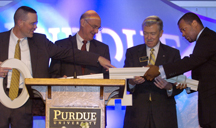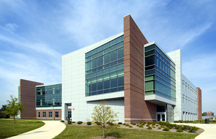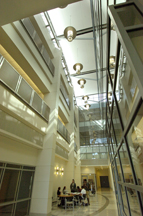
Purdue dedicates biomedical engineering facility
WEST LAFAYETTE, Ind. - Purdue University on Friday (Sept. 22) dedicated its $25 million biomedical engineering building - the first of its kind in Indiana.

|
The building is a joint investment between the state of Indiana and private donors and will be home to the Weldon School of Biomedical Engineering.
"Biomedical engineering is the foundation of one of the key industries in Indiana, and the state is recognized as a leader in the research and development of medical devices such as orthopedic implants," said Purdue President Martin C. Jischke. "Purdue's program will integrate life science initiatives and help us graduate students ready to enter these fields.
"We're building the knowledge base at Purdue to support and grow this vital part of the Indiana economy."
The four-story building will house highly specialized laboratories for biomedical research and development and integrated educational facilities that will involve students in real-world research activities. Many of the projects involve partnerships with Indiana medical device and biotechnology companies specializing in orthopedic, cardiovascular and tissue engineering technologies.

|
"The need for biomedical engineers in industry, health-care environments, as well as academia, will continue to grow," said George Wodicka, head of the School of Biomedical Engineering. "This unique building is a flagship for the field. It will allow us to increase the scale and scope of our research to address a broader set of challenges in preventing, diagnosing and treating disease and will increase our instructional capacity to meet the future demand."
The 91,000-square-foot building has three floors above ground and a basement. The first floor will be primarily used for undergraduate and graduate educational programs and will house hands-on instructional laboratories, advising and counseling offices, classrooms, and meeting space for students. The second and third floors and the basement will be dedicated to interdisciplinary research, housing six core research laboratories concentrating on biomaterials and tissue engineering, biomedical imaging and optics, bionanotechnology and biosensors, neural engineering, orthopedic biomechanics and implants, and computational and systems biology.
Modern communications features in the new structure will enable researchers at Purdue and other institutions around the world to collaborate on research and educational projects remotely.
BSA LifeStructures, an Indianapolis architectural firm, designed the glass, brick and metal building. Maregatti Interiors in Indianapolis provided interior design services. The facility has halls that connect its wings around a central area - a three-story space that promotes interactions among students, staff and faculty.

|
"The building houses the merging fields of engineering and life sciences as they focus on developing new procedures and devices to benefit humankind," said Kalevi Huotilainen, the BSA LifeStructures design leader for the project. "Its design sheds the traditional teaching and spatial models of the past."
The building also will serve as the gateway to Purdue's Discovery Park, a multidisciplinary complex to develop new technologies. The park allows significant collaborations between biomedical engineering faculty members and researchers at the Birck Nanotechnology Center, Bindley Bioscience Center, the Burton D. Morgan Center for Entrepreneurship and the Regenstrief Center for Healthcare Engineering.
Purdue biomedical engineering researchers have made discoveries over the past 15 years that have resulted in more than 70 U.S. patents, the majority of which have been licensed to Indiana companies.
Technologies that have been developed include:
• New devices that monitor the vital signs of premature babies. The ringlike monitor slips over one finger and uses optical sensors to measure vital signs, including blood pressure, heart and respiratory rates.
• Synthetic and natural "biomaterials" used in surgery to repair and regenerate diseased or damaged tissues, such as bladders, blood vessels, ligaments, skin and eyes.
• Materials used to create controlled-release pills and implantable devices that automatically deliver therapeutic drugs to the body.
• Longer-lasting artificial joints and novel minimally invasive orthopedic devices.
• Tiny sensors the size of dust particles that offer promise as future medical diagnostic tools, including those that could be implanted in the body.
• Computer models that simulate the mechanical properties and function of hard and soft tissues to understand the early onset of maladies like stress fractures.
"This building will allow the innovative biomedical engineering research and education that are hallmarks of Purdue to set new standards of excellence," said Leah Jamieson, the John A. Edwardson Dean of Engineering. "The graduate program has already doubled in size to more than 80 students, and the first undergraduate class will graduate this academic year.
"The 15 primary faculty members will be joined by 10 more full-time faculty members in the next two years. This is not merely an expansion at Purdue, but a commitment to continuing the economic growth of Indiana and the country that comes from biomedical engineering."
The Indiana General Assembly authorized Purdue to issue bonds to cover $13 million of the building's cost. The state also provided $7.5 million for 2003-05 to develop the new undergraduate program and expand the graduate program.
A plaque honoring the late Gov. Frank O'Bannon, who was instrumental in securing the funding, hangs at the entrance of the building.
The rest of the building was funded through private donations, including $5 million from the Whitaker Foundation, an independent foundation based in Arlington, Va. The foundation was established as a trust in 1975 to primarily support research and education in biomedical engineering and completed its activities this past year. Grants were made mostly to universities and medical schools to support faculty research, graduate student education and educational program development.
Friday's (Sept. 22) dedication was part of a one-week celebration leading up to Purdue's Homecoming on Saturday (Sept. 23). Events focus on ways Purdue is improving education and helping the state of Indiana as part of the university's strategic plan and $1.5 billion fund-raising campaign.
Writer: Cynthia Sequin, (765) 494-4192, csequin@purdue.edu
Sources: Martin C. Jischke, (765) 494-9708
Leah Jamieson, (765) 494-5346, lhj@purdue.edu
George Wodicka, (765) 494-2998, wodicka@purdue.edu
Purdue News Service: (765) 494-2096; purduenews@purdue.edu
Note to Journalists: Video b-roll is available by contacting Jesica Webb, Purdue News Service, at (765) 494-2079, jwebb@purdue.edu. Additional photos and audio will be available after the event at the same Web site.
PHOTO CAPTION:
Officials on Friday (Sept. 22) assemble a slide rule key to symbolize the official dedication of Purdue's new building that houses the Weldon School of Biomedical Engineering. From left are George Wodicka, head of the School of Biomedical Engineering; Peter G. Katona, past president and CEO of the Whitaker Foundation; Purdue President Martin C. Jischke; and biomedical engineering student Lester Smith of New Orleans. (Purdue News Service photo/David Umberger)
A publication-quality photo is available at https://www.purdue.edu/uns/images/+2006/biomed-key.jpg
PHOTO CAPTION:
An exterior from the southwest corner of Purdue's new $25 million Biomedical Engineering Building. The facility will house the Weldon School of Biomedical Engineering. (Purdue News Service photo/David Umberger)
A publication-quality photo is available at https://www.purdue.edu/uns/images/+2006/biomedical-engr-ext.jpg
PHOTO CAPTION:
Purdue's new $25 million Biomedical Engineering Building was designed by BSA LifeStructures in Indianapolis. The facility features halls that connect its wings to a central area - a three-story space that promotes interactions among students, staff and faculty. (Purdue News Service photo/David Umberger)
A publication-quality photo is available at https://www.purdue.edu/uns/images/+2006/biomedical-engr-int.jpg
To the News Service home page